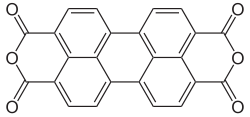PTCDA
| Structural formula | ||||||||||||||||
|---|---|---|---|---|---|---|---|---|---|---|---|---|---|---|---|---|

|
||||||||||||||||
| General | ||||||||||||||||
| Surname | PTCDA | |||||||||||||||
| other names |
|
|||||||||||||||
| Molecular formula | C 24 H 8 O 6 | |||||||||||||||
| Brief description |
dark red solid |
|||||||||||||||
| External identifiers / databases | ||||||||||||||||
|
||||||||||||||||
| properties | ||||||||||||||||
| Molar mass | 392.32 g mol −1 | |||||||||||||||
| Physical state |
firmly |
|||||||||||||||
| Melting point |
> 300 ° C |
|||||||||||||||
| solubility |
|
|||||||||||||||
| safety instructions | ||||||||||||||||
|
||||||||||||||||
| As far as possible and customary, SI units are used. Unless otherwise noted, the data given apply to standard conditions . | ||||||||||||||||
3,4,9,10-Perylenetetracarboxylic acid dianhydride ( PTCDA ) is a pigment used in the development of organic semiconductor devices and manufactured by the colorant industry for commercial applications.
structure
Its molecular structure is based on the polycyclic aromatic hydrocarbon perylene . Two modifications of the crystal structure are known (alpha and beta). The two-dimensional structure of PTCDA layers, which can be generated by molecular beam epitaxy , was examined in detail using scanning tunneling microscopy on various substrates , including graphite , molybdenum disulfide (MoS 2 ), copper and silver. In addition to these metallic substrates, the epitaxy on various insulator surfaces such as NaCl, KCl and KBr was also investigated.
properties
PTCDA is a planar molecule with a two-dimensional conjugated π-electron system, which is delocalized over the entire perylene structure. The anhydride is an organic semiconductor (n-conductor) from the group of two-dimensionally condensed ring systems.
use
As an organic semiconductor , PTCDA can be used e.g. B. use for the production of organic field effect transistors . Derivatives of PTCDA can be used as layer in organic solar cells use or serve as adsorbate to sensitization of titanium dioxide solar cells for visible light . PTCDA is also suitable as a photocatalyst for oxygen production from water using solar energy .
As a pigment , PTCDA is mainly used in high-quality industrial paints , especially in the automotive sector.
Individual evidence
- ↑ a b c data sheet Perylene-3,4,9,10-tetracarboxylic dianhydride from Sigma-Aldrich , accessed on November 5, 2018 ( PDF ).
- ↑ a b Entry on perylene-3,4,9,10-tetracarboxylic acid dianhydride. In: Römpp Online . Georg Thieme Verlag, accessed on March 28, 2014.
- ↑ a b c Chun Ming Jiao, Bing Jun Li, Si Li Yi, Qing Xu: Synthesis and Photoelectric Properties of Donor-Acceptor-Donor Molecule Containing Perylene Diimide . In: Asian Journal of Chemistry . 26, No. 23, 2014, pp. 8049-8052. doi : 10.14233 / ajchem.2014.17040 .
- ↑ T. Ogawa et al .: 3,4: 9,10-Perylenetetracarboxylic dianhydride (PTCDA) by electron crystallography . In: Acta Cryst. B55, 1999, pp. 123-130.
- ↑ HP Wagner et al .: Exciton emission in PTCDA films and PTCDA / Alq3 multilayers . In: Physical Review B 70, 2004, p. 235201.
- ^ C. Ludwig et al .: STM investigations of PTCDA and PTCDI on graphite and MoS2. A systematic study of epitaxy and STM image contrast . In: Z. Phys. B 93, 1994, pp. 365-373.
- ^ Wagner et al .: The initial growth of PTCDA on Cu (111) studied by STM in J. Phys .: Condens. Matter 19, 2007, p. 056009 doi : 10.1088 / 0953-8984 / 19/5/056009
- ↑ Ikonomov et al .: Highly ordered thin films of perylene-3,4,9,10-tetracarboxylic acid dianhydride (PTCDA) on Ag (100) in Surface Science 602, 2008, pp 2061 .
- ↑ Burke et al., Phys. Rev. Lett. 100, 186104 (2008).
- ↑ Le Moal et al., Phys. Rev. B 82, 045301 (2010).
- ↑ Dienel et al., Adv. Mater. 20, 959 (2008).
- ↑ Müller et al., Surface Science 605, 1090 (2011).
- ↑ Kunstmann et al., Phys. Rev. B 71, 121403 (2005).
- ↑ T. Ertl. In: Alkali metal doping of perylenetetracarboxylic dianhydride (PTCDA) , Dissertation, 2001, p. 15
- ↑ R. Hudej, G. Bratina: Electronic transport in perylenetetracarboxylic dianhydride: The role of In diffusion . In: J. Vac. Sci. Technol. A 20, No. 3, 2002, pp. 797-801 (2002).
- ↑ A. Dodabalapur et al .: M olecular Orbital Energy Level Engineering in Organic Transistors . In: Advanced Materials 8, No. 10, 1996, pp. 853-855.
- ↑ CW Tang: Two-layer organic photovoltaic cell . In: Appl. Phys. Lett. 48, No. 2, 1986, pp. 183-185.
- ^ S. Ferrere, BA Gregg: New perylenes for dye sensitization of TiO 2 . In: New J. Chem. 26, 2002, pp. 1155-1160.
- ↑ CA Linkous, D. K Slattery: Solar photocatalytic hydrogen production from water using a dual bed photosystem (PDF; 86 kB) . In: Proceedings of the 2000 Hydrogen Program Annual Review, Volume I.
- ↑ W. Herbst, K. Hunger: Industrial organic pigments. Production, properties, application . 2nd edition, Wiley-VCH, Weinheim 1995, ISBN 3-527-28744-2 .
